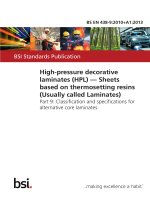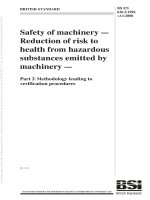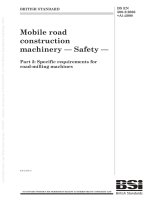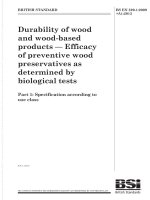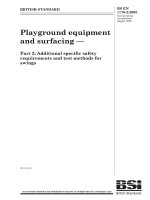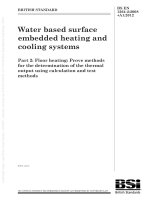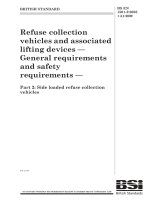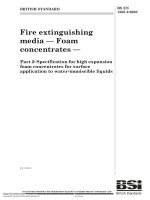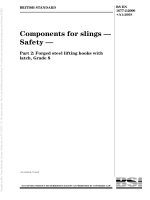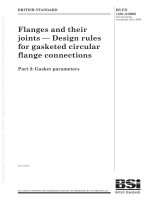Bsi bs en 00716 2 2008 + a1 2013
Bạn đang xem bản rút gọn của tài liệu. Xem và tải ngay bản đầy đủ của tài liệu tại đây (1.75 MB, 40 trang )
BRITISH STANDARD
Furniture — Children’s
cots and folding cots
for domestic use —
Part 2: Test methods
ICS 97.140; 97.190
BS EN
716-2:2008
+A1:2013
BS EN 716-2:2008+A1:2013
National foreword
This British Standard is the UK implementation of
EN 716-2:2008+A1:2013. It supersedes BS EN 716-2:2008,
which is withdrawn.
The start and finish of text introduced or altered by amendment is
indicated in the text by tags. Tags indicating changes to CEN text
carry the number of the CEN amendment. For example, text altered
by CEN amendment A1 is indicated by !".
The UK participation in its preparation was entrusted by
Technical Committee CW/1, Safety of child use and child care
products, to Technical Subcommittee CW/1/5, Nursery furniture.
A list of organizations represented on this subcommittee can be
obtained on request to its secretary.
This publication does not purport to include all the necessary
provisions of a contract. Users are responsible for its correct
application.
Compliance with a British Standard cannot confer immunity
from legal obligations.
This British Standard was
published under the authority
of the Standards Policy and
Strategy Committee
on 31 July 2008
© The British Standards
Institution 2013. Published by
BSI Standards Limited 2013
ISBN 978 0 580 70909 8
Amendments/corrigenda issued since publication
Date
Comments
28 February 2013
Implementation of CEN amendment A1:2013
EUROPEAN STANDARD
EN 716-2:2008+A1
NORME EUROPÉENNE
EUROPÄISCHE NORM
January 2013
ICS 97.140
English Version
Furniture - Children's cots and folding cots for domestic use Part 2: Test methods
Meubles - Lits à nacelle fixes et pliants à usage domestique
pour enfants - Partie 2 : Méthodes d'essai
Möbel - Kinderbetten und Reisekinderbetten für den
Wohnbereich - Teil 2: Prüfverfahren
This European Standard was approved by CEN on 2 February 2008 and includes Amendment 1 approved by CEN on 17 November 2012.
CEN members are bound to comply with the CEN/CENELEC Internal Regulations which stipulate the conditions for giving this European
Standard the status of a national standard without any alteration. Up-to-date lists and bibliographical references concerning such national
standards may be obtained on application to the CEN-CENELEC Management Centre or to any CEN member.
This European Standard exists in three official versions (English, French, German). A version in any other language made by translation
under the responsibility of a CEN member into its own language and notified to the CEN-CENELEC Management Centre has the same
status as the official versions.
CEN members are the national standards bodies of Austria, Belgium, Bulgaria, Croatia, Cyprus, Czech Republic, Denmark, Estonia,
Finland, Former Yugoslav Republic of Macedonia, France, Germany, Greece, Hungary, Iceland, Ireland, Italy, Latvia, Lithuania,
Luxembourg, Malta, Netherlands, Norway, Poland, Portugal, Romania, Slovakia, Slovenia, Spain, Sweden, Switzerland, Turkey and United
Kingdom.
EUROPEAN COMMITTEE FOR STANDARDIZATION
COMITÉ EUROPÉEN DE NORMALISATION
EUROPÄISCHES KOMITEE FÜR NORMUNG
Management Centre: Avenue Marnix 17, B-1000 Brussels
© 2013 CEN
All rights of exploitation in any form and by any means reserved
worldwide for CEN national Members.
Ref. No. EN 716-2:2008+A1:2013: E
BS EN 716-2:2008+A1:2013
EN 716-2:2008+A1:2013 (E)
Contents
Page
Foreword ..............................................................................................................................................................4
1
Scope ......................................................................................................................................................5
2
Normative references ............................................................................................................................5
3
3.1
3.2
3.3
3.4
3.5
3.6
General test conditions .........................................................................................................................5
Preliminary preparation ........................................................................................................................5
Test equipment ......................................................................................................................................5
Application of forces .............................................................................................................................6
Tolerances ..............................................................................................................................................6
Test sequence ........................................................................................................................................6
Prevention of movement during test ...................................................................................................6
4
4.1
4.2
4.3
4.4
4.5
4.6
4.7
4.8
4.9
4.10
4.11
4.12
4.13
4.14
4.14.1
4.14.2
4.15
4.16
Test apparatus .......................................................................................................................................6
Measuring probes ..................................................................................................................................6
Bottom impactor ....................................................................................................................................7
Test mattress..........................................................................................................................................8
Side impactor .........................................................................................................................................8
Loading pad ............................................................................................................................................9
Stops .......................................................................................................................................................9
Floor surface ....................................................................................................................................... 10
Test chain and mass .......................................................................................................................... 10
Small parts cylinder ............................................................................................................................ 10
Test mass ............................................................................................................................................ 11
Bite tester ............................................................................................................................................ 11
Retaining block ................................................................................................................................... 12
Foothold template ............................................................................................................................... 12
Head probes ........................................................................................................................................ 13
Small head probe ................................................................................................................................ 13
Large head probe ................................................................................................................................ 14
Template for V-shaped openings ...................................................................................................... 14
Test dummy ......................................................................................................................................... 15
5
5.1
5.2
5.3
5.3.1
5.3.2
5.3.3
5.4
5.4.1
5.4.2
5.5
5.5.1
5.5.2
5.5.3
5.6
5.7
5.7.1
5.7.2
5.8
5.8.1
Test procedures .................................................................................................................................. 15
Assembly and inspection .................................................................................................................. 15
!Stability - test" ........................................................................................................................... 16
Footholds............................................................................................................................................. 16
!Determination of a foothold" .................................................................................................... 16
!Tests for footholds" .................................................................................................................. 18
!Measurement of distance between footholds and/or top of cot sides and ends".............. 21
Measurements ..................................................................................................................................... 21
Holes, gaps and openings inside the cot ......................................................................................... 21
Holes, gaps and openings on the outside of the cot ...................................................................... 22
Small parts ........................................................................................................................................... 24
General ................................................................................................................................................. 24
Torque test .......................................................................................................................................... 24
Tension test ......................................................................................................................................... 25
Bite test ................................................................................................................................................ 25
!Tests for cot base and mattress base".................................................................................... 26
!Folding test of the mattress base and cot base" ................................................................... 26
!Strength of cot base and mattress base (impact test)" ........................................................ 26
Strength of sides and ends ................................................................................................................ 27
Static load test of !deleted text" slats (bending test) .............................................................. 27
2
BS EN 716-2:2008+A1:2013
EN 716-2:2008+A1:2013 (E)
5.8.2
5.8.3
5.8.4
5.9
5.9.1
5.9.2
5.10
5.11
5.11.1
5.11.2
5.12
Strength of sides or side slats (impact test)..................................................................................... 27
Strength of corners (impact test) ....................................................................................................... 30
Strength of mesh and flexible sides and ends (static load test) .................................................... 30
Strength of frame and fastenings ...................................................................................................... 31
Vertical static load test ....................................................................................................................... 31
Durability test ....................................................................................................................................... 32
Snag points .......................................................................................................................................... 33
Locking mechanisms .......................................................................................................................... 33
Durability .............................................................................................................................................. 33
Strength ................................................................................................................................................ 33
Stability test ......................................................................................................................................... 33
6
Test report ............................................................................................................................................ 33
Annex A (informative) !A–deviations" ................................................................................................... 35
Bibliography ...................................................................................................................................................... 36
3
BS EN 716-2:2008+A1:2013
EN 716-2:2008+A1:2013 (E)
Foreword
This document (EN 716-2:2008+A1:2013) has been prepared by Technical Committee CEN/TC 207
“Furniture”, the secretariat of which is held by UNI.
This European Standard shall be given the status of a national standard, either by publication of an identical
text or by endorsement, at the latest by July 2013, and conflicting national standards shall be withdrawn at the
latest by July 2013.
Attention is drawn to the possibility that some of the elements of this document may be the subject of patent
rights. CEN [and/or CENELEC] shall not be held responsible for identifying any or all such patent rights.
This document supersedes !EN 716-2:2008."
This document includes Amendment 1 approved by CEN on 17 November 2012.
The start and finish of text introduced or altered by amendment is indicated in the text by tags !".
Significant technical differences between this edition and EN 716-2:1995 are as follows:
a) Following items were made more concrete or introduced: Test equipment (3.2), Application of forces (3.3),
Tolerances (3.4) and under Test equipment (4), Test mattress (4.3), Device for bite test (4.11), Template
for foot hold (4.13), Head probes (4.14), Testing device for V-shaped openings (4.15) and Retaining block
(4.12);
b) Elaboration and specification of the test procedures (5), Assembly and inspection (5.1), for the
measurements of closed openings testing with at test probe (5.3.2.1) and measurement of V-shaped
openings testing with a test probe (5.3.2.2) were introduced, Small parts (5.4), Bite test (5.5), Strength of
sides and ends (5.7), Snag points (5.9) and Locking mechanisms (5.11);
c) Testing of brakes of the rollers and test chain with disc were deleted;
d)
Revised editorially and with regard to content.
According to the CEN/CENELEC Internal Regulations, the national standards organisations of the following
countries are bound to implement this European Standard: Austria, Belgium, Bulgaria, Croatia, Cyprus, Czech
Republic, Denmark, Estonia, Finland, Former Yugoslav Republic of Macedonia, France, Germany, Greece,
Hungary, Iceland, Ireland, Italy, Latvia, Lithuania, Luxembourg, Malta, Netherlands, Norway, Poland, Portugal,
Romania, Slovakia, Slovenia, Spain, Sweden, Switzerland, Turkey and the United Kingdom.
4
BS EN 716-2:2008+A1:2013
EN 716-2:2008+A1:2013 (E)
1
Scope
This part of EN 716 specifies test methods for assessing the safety of children's cots and folding cots for
domestic use.
It applies to children’s cots and folding cots with an internal length greater than 900 mm but not more than
1 400 mm.
2
Normative references
The following referenced documents are indispensable for the application of this document. For dated
references, only the edition cited applies. For undated references, the latest edition of the referenced
document (including any amendments) applies.
EN ISO 2439:2000, Flexible cellular polymeric materials - Determination of hardness (indentation technique)
(ISO 2439:1997, including Technical Corrigendum 1:1998)
ISO 7619-2, Rubber, vulcanized or thermoplastic — Determination of indentation hardness — Part 2: IRHD
pocket meter method
3
3.1
General test conditions
Preliminary preparation
The tests are designed to be applied to a cot that is fully assembled and ready for use.
The test unit shall be stored in indoor ambient conditions for at least one week immediately prior to testing.
Any deviation from this procedure shall be stated in the test report.
Before testing, any fabrics intended to be removable shall be cleaned or washed twice in accordance with the
manufacturer's instructions. If no instructions are supplied, the manner of washing/cleaning shall be stated in
the test report.
The tests shall be carried out under indoor ambient conditions, but if during a test the atmospheric
temperature is outside the range 15 °C to 25 °C, the maximum and/or minimum temperature shall be recorded
in the test report.
The cot shall be tested as delivered. If the cot is a knock down type, it shall be assembled according to the
manufacturer's instructions supplied with the cot. If the cot can be assembled, combined or adjusted in
different ways, the most adverse combination shall be used for each test.
Knock-down fittings shall be tightened before testing. Further re-tightening shall not take place unless this is
specifically required by the manufacturer.
In the case of designs not catered for in the test procedures, the tests shall be carried out as far as possible
as described, and a list made of the deviations from the test procedures.
3.2
Test equipment
Unless otherwise specified, the tests may be applied by any suitable device because results are dependent
only upon correctly applied forces and loads and not upon the apparatus.
5
BS EN 716-2:2008+A1:2013
EN 716-2:2008+A1:2013 (E)
The equipment shall not inhibit the deformation of the cot during testing. It shall be able to move so that it can
follow the deformation of the cot during testing, so that the loads are always applied at the specified point and
in the specified direction.
All loading pads shall be capable of pivoting in relation to the direction of the applied force. The pivot point
shall be as close as practically possible to the load surface.
3.3
Application of forces
The forces in the static load tests shall be applied sufficiently slowly enough to ensure that negligible dynamic
force is applied.
The forces in durability tests shall be applied at a rate to ensure that excessive heating does not occur.
3.4
Tolerances
Unless otherwise stated, the following tolerances apply:
Forces:
± 5 % of the nominal force;
Masses:
± 0,5 % of the nominal mass;
Dimensions: ± 1,0 mm of the nominal dimension;
Angles:
Positioning of loading pads: ± 5 mm;
Duration of forces: ( 2 ± 1) s for durability tests
(10 ± 2) s for static load tests, including tension, torque and bite tests.
± 2° of the nominal angle;
The tests are described in terms of the application of forces. Masses can, however, be used. The relationship
10 N = 1 kg shall be used for this purpose.
3.5
Test sequence
The tests shall be carried out in the order laid down in this standard and on the same cot.
3.6
Prevention of movement during test
If the cot tends to slide or roll during the tests specified in clause 5, it shall be restrained by stops (4.6).
4
4.1
Test apparatus
Measuring probes
Probes made of plastics or other hard, smooth material mounted on a force-measuring device.
There shall be one probe with a diameter of 7 mm (-0,1/+0 mm), see Figure 1a.
There shall be five probes with an angle of 30° ± 0,5° with diameters of 25 mm (0/+0,1 mm), 45 mm (0/+0,1
mm), 60 mm (0/+0,1 mm), 65 mm (0/+0,1 mm) and 85 mm (0/+0,1 mm) with conical ends, see Figure 1b.
6
BS EN 716-2:2008+A1:2013
EN 716-2:2008+A1:2013 (E)
There shall be four cylindrical probes with diameters of 5 mm (-0,1/+0 mm), 7 mm (-0,1/+0 mm), 12 mm
(0/+0,1 mm) and 18 mm (0/+0,1 mm) with hemispherical ends, see Figure 1c.
Figure 1 a— 7 mm probe
Figure 1 b — Conical probes
Figure 1 c — Cylindrical probes
Key
1
Ø 5 mm (-0,1/+0 mm), Ø 7 mm (-0,1/+0 mm), Ø 12 mm (0/+0,1 mm), Ø 18 mm (0/+0,1 mm)
Figure 1
4.2
Bottom impactor
An impactor with a total mass of 10 kg of hardwood or equivalent material with a hemispherical end and with
dimensions in accordance with Figure 2.
The impactor shall be guided so that it is kept vertical and always falls on the impact point.
7
BS EN 716-2:2008+A1:2013
EN 716-2:2008+A1:2013 (E)
Dimensions in millimetres
Figure 2 — Bottom impactor
4.3
Test mattress
3
A PUR foam sheet with a thickness of 60 mm, a bulk density of (35 ± 2) kg/m and an indentation hardness
index of (170 ± 40) N in accordance with A.40 of EN ISO 2439:2000 and being at least 400 mm × 800 mm in
area but not larger than the mattress base of the cot under test. The test mattress shall have a cotton cover
2
2
with a mass per unit area of 100 g/m to 120 g/m .
4.4
Side impactor
A pendulum with a cylindrical head made of steel (Figure 3). The head of the pendulum shall be surrounded
by a 10 mm thick layer of rubber of hardness 76 IRHD to 78 IRHD in accordance with ISO 7619-2. The total
mass shall be 2 kg.
8
BS EN 716-2:2008+A1:2013
EN 716-2:2008+A1:2013 (E)
Dimensions in millimetres
Key
1 Pivot point
2 Centre of gravity
3 Rubber 76 to 78 IRHD
Figure 3 — Side impactor
4.5
Loading pad
A rigid cylindrical object, 100 mm in diameter, having a smooth hard surface and rounded edge with radius of
12 mm.
4.6
Stops
Stops which prevent the article from sliding but not tilting, not higher than 12 mm except in cases where the
design of the item necessitates the use of higher stops, in which case the lowest that will prevent the item
from sliding shall be used.
9
BS EN 716-2:2008+A1:2013
EN 716-2:2008+A1:2013 (E)
4.7
Floor surface
Rigid, horizontal and flat surface.
4.8
Test chain and mass
Ball chain with a ball diameter of (3,2 ± 0,2) mm and a distance between ball centres of (4,0 ± 0,2) mm
(Figure 4), fixed to a 2,5 kg spherical weight with a diameter of 115 mm forming a loop in accordance with
Figure 5.
Dimensions in millimetres
Figure 4 — Ball chain
Dimensions in millimetres
Key
1 Ball chain
2 Weight, mass 2,5 kg
3 Fixing point
Figure 5 — Test chain and mass
4.9
Small parts cylinder
For assessment of small components, having dimensions in accordance with Figure 6.
NOTE
10
The cylinder is identical to the one specified in EN 71-1 [1].
BS EN 716-2:2008+A1:2013
EN 716-2:2008+A1:2013 (E)
Dimensions in millimetres
Figure 6 — Small parts cylinder
4.10 Test mass
A weight having a mass of 10 kg and a cross-section of 100 mm × 30 mm.
4.11 Bite tester
An apparatus (Figure 8), consisting of two sets of teeth (Figure 7), made from H13 high chrome tool steel or
equivalent and hardened to 45 Rockwell C to 50 Rockwell C. There shall be two teeth at the top and two at
the bottom of the bite tester, positioned so that the vertical centre line of one pair of teeth is (1 ± 0,1) mm in
front of the centre line of the other set of teeth. In the fully closed position the teeth shall overlap each other by
(1 ± 0,1) mm. The outer most corners of the teeth shall have a radius of (0,3 ± 0,1) mm.
The teeth shall be mounted so as to pivot about a point (50 ± 1) mm from the rear most pair of teeth and
positioned so that when closed the centre lines of the two pairs of teeth are parallel to each other. The bite
tester shall be equipped with a stop to prevent the distance between the teeth from exceeding (28 ± 1) mm
when fully opened. The closing force of the teeth shall be set at (50 ± 5) N.
The bite tester shall be provided with a guide to prevent items entering further into the fully opened jaws by
more than (17 ± 1) mm. The bite tester shall be equipped with a means whereby a force of (50 ± 5) N may be
applied along its centre line in a direction tending to pull the teeth off the sample.
11
BS EN 716-2:2008+A1:2013
EN 716-2:2008+A1:2013 (E)
Dimensions in millimetres
Figure 7 — Test teeth
Dimensions in millimetres
Key
1 Position of guide
2 Pivot point
Figure 8 — Bite tester
4.12 Retaining block
Two retaining blocks made of rigid material with a width of 50 mm and a radius of 5 mm at the front edges.
4.13 Foothold template
A strip of 10 mm thick transparent material cut to the shape as shown in Figure 9, marked on one face with
the pattern as shown.
12
BS EN 716-2:2008+A1:2013
EN 716-2:2008+A1:2013 (E)
The sides of the template shall be at a right angle to the faces. All edges and corners shall be without any
radius.
Dimensions in millimetres
Key
1
Triangular cells plotted on a 5 x 5 grid
Figure 9 — Template for foothold test (example of left hand template)
Two templates are required to provide a left and right hand template. The markings shown in Figure 9 shall be
on the bottom face of each template to avoid parallax errors.
4.14 Head probes
4.14.1 Small head probe
The small head probe shall be made from plastics or other hard, smooth material with the dimensions given in
Figure 10. The radius shall be 53 mm.
NOTE
The small head probe represents a child aged 6 months to 9 months.
13
BS EN 716-2:2008+A1:2013
EN 716-2:2008+A1:2013 (E)
Dimensions in millimetres
Key
a = 106 mm
b = 145 mm
c = 126 mm
Figure 10 — Small head probes
4.14.2 Large head probe
The large head probe shall be made from plastics or other hard, smooth material with the dimensions given in
Figure 11.
NOTE
The large head probe represents a child aged up to 36 months.
Dimensions in millimetres
Key
a = 223 mm
Figure 11 — Large head probe
4.15 Template for V-shaped openings
The template for V and irregular shaped openings shall be made from plastics or other hard, smooth material
°
with the dimensions given in Figure 12. The tolerance for the angles shall be ± 1 .
14
BS EN 716-2:2008+A1:2013
EN 716-2:2008+A1:2013 (E)
Dimensions in millimetres
Key
1
2
B portion
A portion
Figure 12 — V and irregular shaped openings template
4.16 Test dummy
A solid cylinder 200 mm in diameter and 300 mm in height, having a mass of 15 kg and with its centre of
gravity 150 mm above its base. All the edges of the cylinder shall have a radius of 5 mm.
5
5.1
Test procedures
Assembly and inspection
Assemble the cot in accordance with the manufacturer's instruction. Prior to the test, inspect the cot visually
for defects.
Tighten all knock-down fittings.
After testing, check where appropriate:
whether there are sharp edges or burrs,
whether the functions of the locking mechanisms are impaired,
whether the functions of the cot are impaired,
whether the sizes of the openings have changed so that they present a safety hazard,
if relevant, whether the stability of the cot has changed.
15
BS EN 716-2:2008+A1:2013
EN 716-2:2008+A1:2013 (E)
!
5.2
Stability - test
The cot shall be tested without mattress unless the mattress is an integral part of the cot.
Position the cot on the floor (4.7) with the legs against the stops (4.6). The tilting tendencies shall not be
restrained.
Adjust the cot base to its highest position.
Attach the test mass (4.10) on the inside at the centre of the upper edge of the cot side/end so that its centre
of gravity is 50 mm below the upper edge of the cot side/end (Figure 13). At the same side/end, apply a force
of 30 N horizontally outwards at the centre of the upper edge of the cot side/end.
Record whether the cot overturns.
Dimensions in millimetres
Figure 13 — Stability"
5.3
Footholds
!
5.3.1
"Determination of a foothold
!
5.3.1.1
General
Seams in fabrics of multiple layers are not considered as footholds."
!
16
BS EN 716-2:2008+A1:2013
EN 716-2:2008+A1:2013 (E)
5.3.1.2
Continuous structure"
A foothold exists on a continuous structure if four triangles marked on the template are completely obscured
by the structure being checked. These four triangles shall have at least one side in common with another of
the triangles, see !Figure 14".
!
Key
This shaded area denotes one triangle; four shaded areas denote four covered triangles
Figure 14 — Examples of obscured triangles indicating a foothold on a continuous structure"
!
5.3.1.3
Non-continuous structure"
A foothold exists on a non-continuous structure if two or more triangles marked on the template are
completely obscured between the edge of the template and the bold lines of the template by the structure
being checked. The two or more triangles on either side of the template shall have at least one side in
common with each other, see !Figure 15".
!
Key
This shaded area denotes one triangle
Figure 15 — Examples of obscured triangles on a foothold on a non-continuous structure"
!
17
BS EN 716-2:2008+A1:2013
EN 716-2:2008+A1:2013 (E)
5.3.1.4
Wire, thin structures and similar parts"
A foothold exists on a wire, thin structure and similar part if it projects across the bold lines on the template,
see !Figure 16". Any wire, thin structure or similar part with a maximum width of 5 mm shall be checked
in accordance with 5.2.2.3.
!
Key
This denotes a wire, thin structure or similar structure
Figure 16 — Example of a foothold on a wire, thin structure and similar part"
!
5.3.2
5.3.2.1
Tests for footholds"
Footholds on a continuous structure at an angle less than 55°
Using either the left or right hand template, place the template with its marked face on any continuous
structure inclined at less than 55° to the horizontal. Orientate either template, !Figure 10", to check
whether four triangles are obscured; see !Figure 17".
5.3.2.2
Footholds on a non-continuous structure at an angle of less than 55°
Using either the left or right hand template, place the template with its marked face on any non-continuous
structure inclined at less than 55° to the horizontal. Orientate either template, !Figure 10", to check
whether any triangles are obscured on either side of the bold lines on the template; see !Figure 18".
5.3.2.3
Wire, thin structures or similar parts at an angle less than 55°
Using either the left or right hand template, place the template with its marked face on any wire, thin structure
or similar parts at an angle less than 55° to the horizontal. Check whether the wire, thin structure or similar
part has a line of contact extending between the two bold lines marked along the template, !Figure 10".
See !Figure 19" for examples.
5.3.2.4
Intersecting or adjacent structures where the second structure prevents slipping
Using either the left or right hand template, place the template with its marked face on any structure, thin
structure or similar parts between 55° and 80° to the horizontal where there is also a supporting structure.
Orientate either template, !Figure 10", to check whether any four triangles are obscured.
See !Figure 20" for examples.
18
BS EN 716-2:2008+A1:2013
EN 716-2:2008+A1:2013 (E)
!
Figure 17 — Examples of footholds on a continuous structure at an angle less than 55°"
!
Figure 18 — Examples of footholds on a non-continuous structure at an angle less than 55°"
19
BS EN 716-2:2008+A1:2013
EN 716-2:2008+A1:2013 (E)
!
Figure 19 — Examples of footholds on wire, thin structures and similar parts at an angle less than
55°"
!
"
Figure 20 — Example of footholds on intersecting or adjacent structures where the second structure
prevents slipping
5.3.2.5
Flexible materials
!Where flexible materials or fabrics are covering rigid components, the template shall be pushed against the
flexible material or fabric with a horizontal force of up to 30 N acting along the longitudinal axis of the template.
Orientate either template, Figure 10, to check whether any four triangles are obscured by the rigid
components indicating a foothold."
!Rigid components do not include fabrics, seams in fabrics of multiple layers."
20
BS EN 716-2:2008+A1:2013
EN 716-2:2008+A1:2013 (E)
!
5.3.3
Measurement of distance between footholds and/or top of cot sides and ends"
Measure the distance between the top of any foothold and the top of the cot side and end in any direction,
see !Figure 21". Footholds include also the top of the cot base and the top of the mattress base, but
exclude the top of the cot side and end.
!When measuring from the mattress base, the measurement shall be carried out with the test dummy (4.16)
on the mattress base. The measurement shall be taken from the bottom of the test dummy."
!
Figure 21 — Example of measurement between footholds and/or top of cot sides and ends"
!deleted text"
5.4
5.4.1
Measurements
Holes, gaps and openings inside the cot
Press the applicable measuring probe (4.1) with a force as specified in Table 1 between the wires of the mesh,
the slats of the cot base, the side slats and between the cot base and the sides and ends.
21
BS EN 716-2:2008+A1:2013
EN 716-2:2008+A1:2013 (E)
Table 1 — Measuring probe diameters and applied forces
Holes, gaps and openings
Cylindrical probe
diameter in mm
Cone diameter
in mm
Force in N
Shear and squeeze points
5
-
No force
Shear and squeeze points
18
-
No force
Mesh of sides and ends
-
7
30
Diameter of holes, clearance between
structural members
-
Diameter of holes, clearance between
structural members
-
Distance between cot base and sides
and ends
-
Slats of the cot base
-
60
30
Mesh of cot base
-
85
90
All other holes, gaps and openings
7
25 and 65
30
All other holes, gaps and openings
12
45
No force
5.4.2
5.4.2.1
45
65
25
No force
30
30
Holes, gaps and openings on the outside of the cot
Completely bound holes, gaps and openings
Press the small head probe (4.14.1) with the highest force possible up to 30 N into completely bound
openings. If the small head probe passes completely through the opening, check whether the large head
probe (4.14.2) passes completely through the completely bound opening with a force of up to 5 N. If
completely bound openings contain V or irregular shaped openings, they shall also be tested in accordance
with 5.3.2.2.
5.4.2.2
Partially bound, V and irregular shaped holes, gaps and openings
Position the ‘B’ portion of the template (4.15) between and perpendicular to the boundaries of the opening, as
shown in !Figure 23 or Figure 24" as appropriate. If the full thickness of the template cannot be inserted
there is no hazard, but if the full thickness of the template can be inserted there is a hazard, see !Figure 22
and Figure 23".
If the template (4.15) can be inserted to a depth greater than the thickness of the template (45 mm), apply the
‘A’ portion of the template, so that its centre line is in line with the centre line of the opening. Ensure that the
plane of the template is parallel and applied in line with the opening, as shown in !Figure 24". Insert the
template along the centre line of the opening until its motion is arrested by contact with the boundaries of the
opening. If the template touches the bottom of the opening there is no hazard, but if the sides of the template
touch the sides of the opening there is a hazard, see !Figure 24".
22
BS EN 716-2:2008+A1:2013
EN 716-2:2008+A1:2013 (E)
!
Key
1 and 2 are not a hazard
3 and 4 are a hazard
Figure 22 — Method of insertion of portion B"
!
Key
1 is not a hazard
2 is a hazard
Figure 23 — Method of insertion of portion B"
23
